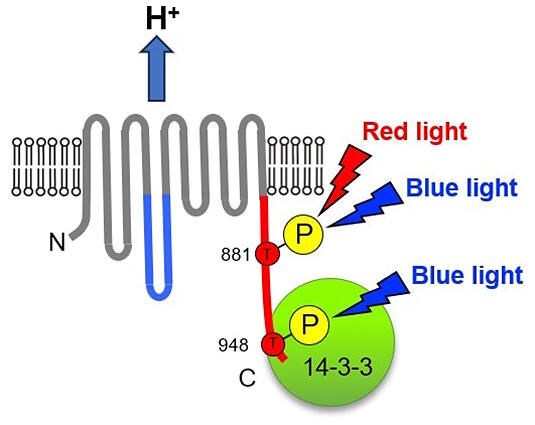A research group led by Professor Toshinori Kinoshita of the Institute of Transformative Bio-Molecules (WPI-ITbM) and Assistant Professor Yuki Hayashi (Kato) of the Graduate School of Science at Nagoya University announced that they have clarified the regulatory mechanism of red light activation of plasma membrane H+-ATPase that provides the driving force for stomatal opening. New phosphorylation sites were found in guard cells, and both red and blue light induced the phosphorylation and activation of plasma membrane H+-ATPase. Since plasma membrane H+-ATPase is involved in various physiological phenomena, these findings are expected to lead to increased crop yields and other benefits. The results were published in the February 20, 2024 issue of the international academic journal Nature Communications.

Provided by Yuki Hayashi, Graduate School of Science, Nagoya University.
Through stomata, the exchange of gases between plants and the atmosphere occurs, including the uptake and transpiration of carbon dioxide and the release of oxygen for photosynthesis. Stomata consist of a pair of guard cells that open in response to red and blue light in sunlight. Notably, the light from each color alone hardly opens the stomata.
When blue light hits the guard cells, a photoreceptor called phototropin is activated, and signal transduction causes the stomata to open via activation of the enzyme known as plasma membrane H+-ATPase. By contrast, red light triggers photosynthesis in chloroplasts and activates plasma membrane H+-ATPase via signal transduction. However, it was not known how red light is involved in stomatal opening.
The research group had studied the mechanisms behind the environmental stimuli that drive stomatal opening, especially the response to light, and elucidated the main components involved in the response to blue light.
Phosphorylation of the second threonine residue at the C-terminus (Thr948) of plasma membrane H+-ATPase was found to be dependent on blue light and necessary for proton pump activation. Moreover, increased protein levels promoted stomatal opening, which increased the photosynthetic activity, growth, and yield of plants.
In this study, the research group focused on protein phosphorylation, which is involved in the regulation of protein activity. Phosphoproteomic analysis was performed to exhaustively study phosphorylation in guard-cell protoplasts (GCPs; a cell population with the cell membranes removed), which were obtained in large quantities by isolating only guard cells from Vicia faba. Comprehensive phosphoproteomics was performed on each GCP under dark, red light, and red + blue light conditions, and numerous phosphorylated proteins were found. Among them, the 881st threonine (Thr881) in plasma membrane H+-ATPase was found to be phosphorylated by red light irradiation, and its phosphorylation was further increased when it was irradiated with red + blue light.
To investigate the function of Thr881, GCPs were generated in Arabidopsis thaliana (a model plant species for which analytical tools are abundant) and examined to determine if similar phosphorylation occurred. As a result, a similar response was observed in the A. thaliana GCPs.
The degrees of stomatal opening and gas exchange efficiency were studied under dark and red + blue light irradiation conditions in three types of plants: wild-type plants; a plasma membrane H+-ATPase-deficient mutant (in which stomata do not open when exposed to light); and transformed plants in which only Thr881 is defective in phosphorylation. In the transformed plants, the degrees of stomatal opening and gas exchange efficiency were suppressed to approximately 40% of those in the wild-type plants but were still higher than those in the mutants. This indicates that phosphorylation of Thr881 is induced by both red and blue light and is required for stomatal opening.
Hayashi said, "The identification of a new phosphorylation regulation of plasma membrane H+-ATPase has revealed part of the molecular mechanism linking the effects of red and blue light. Clarification of how the two phosphorylation sites regulate the activity of plasma membrane H+-ATPase is challenge that remains for the future. However, this discovery is interesting in itself, because plasma membrane H+-ATPase is likely to be subject to very complex and delicate regulation of its activity. We expect to develop applications to artificially control the H+-ATPase activity. We hope to do more research on this topic in the future."
Journal Information
Publication: Nature Communications
Title: Phosphorylation of plasma membrane H+-ATPase Thr881 participates in light-induced stomatal opening
DOI: 10.1038/s41467-024-45248-5
This article has been translated by JST with permission from The Science News Ltd. (https://sci-news.co.jp/). Unauthorized reproduction of the article and photographs is prohibited.




